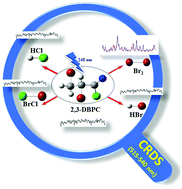Photodissociation of CH2BrCHBrC(O)Cl at 248 nm: probing Br2 as the primary fragment using cavity ring-down spectroscopy†
Abstract
The photodissociation of 2,3-dibromopropionyl chloride (CH2BrCHBrC(O)Cl, 2,3-DBPC) at 248 nm was carried out to study Br2 as the primary molecular product in the B3Π+0u ← X1Σ+g transition using cavity ring-down absorption spectroscopy. The rotational spectra (v′′ = 0–2) were acquired and assigned with the aid of spectral simulation. It is verified that the obtained Br2 fragment is attributed to the one-photon dissociation of 2,3-DBPC and is free from contributions of secondary reactions. The vibrational ratio of the Br2 population of v(0):v(1):v(2) is equal to 1:(0.58 ± 0.12):(0.23 ± 0.09), corresponding to the Boltzmann vibrational temperature of 623 ± 38 K. The quantum yield of Br2 eliminated from 2,3-DBPC is estimated to be 0.09 ± 0.04. The dissociation pathways of 2,3-DBPC and its potential energy surfaces were calculated using density functional theory. By employing the CCSD(T)//M062X/6-31+g(d,p) level of theory, transition state barriers and corresponding reaction energies were calculated for the Br, Cl, Br2, BrCl, HBr and HCl elimination channels. The unimolecular rate constant for Br2 elimination was determined to be 2.09 × 105 s−1 using Rice–Ramsperger–Kassel–Marcus (RRKM) theory, thus explaining the small quantum yield of the Br2 channel.



 Please wait while we load your content...
Please wait while we load your content...